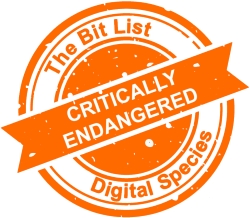Correspondence and Records of Research
 |
||
|
Correspondence and other records which describe the configuration and delivery of research, but which are ancillary to the core research outputs, including reviews, drafts and correspondence between researchers. |
||
|
Digital Species: Research Outputs |
Trend in 2022:
|
Consensus Decision |
|
Added to List: 2019 |
Trend in 2023:
|
Previously: Critically Endangered |
|
Imminence of Action Action is recommended within three years, detailed assessment in one year. |
Significance of Loss The loss of tools, data or services within this group would impact on many people and sectors. |
Effort to Preserve | Inevitability Loss seems likely: by the time tools or techniques have been developed the material will likely have been lost. |
|
Examples Email boxes of senior academics; social media posts; personal spaces on institutional networks. |
||
|
‘Practically Extinct’ in the Presence of Aggravating Conditions Originating researcher no longer active or changed research focus; staff on temporary contracts; dependence on single student or staff member; weak or fluid institutional commitment to subject matter; weak institutional commitment to data sharing; complicated or contested intellectual property; encryption. |
||
|
‘Endangered’ in the Presence of Good Practice Recognition of value of correspondence; integration with CRIS; routine use of EDRMS; documented and managed professionally; separation of personal and corporate identities. |
||
|
2023 Review This entry was introduced in 2017 under ‘Research Data,’ though without specific reference to the correspondence and records of research. In 2019, the Jury split this entry into a range of contexts for research outputs. There was a 2020 trend towards greater risk based on education and research institutions facing budget uncertainties, and a number of institutions have introduced early severance schemes or put staff on short term contracts at greater risk of redundancy and, while this puts other types of research output at risk, the personal nature of correspondence means that the risks are intensified, and so this item faces greater risks than identified in 2019. However, the 2021 Jury agreed there had been no significant change in the trend over the preceding year indicating a trend towards increased or reduced risk. The 2023 Council agreed with the Critically Endangered risk classification. |
||
|
Additional Comments In an ideal circumstance, correspondence should be stored in EDRMS systems separately from research data and subject to different retention schedules, i.e., 10-20 years. There may be challenges connecting the EDRMs holdings to the research data and vice versa. Advocacy and research re the scale of the problem may be required to encourage academics to use EDRMs, for example, correspondence and integration with CRIS. Simplified tools and workflows to move data from CRIS to Repository to Preservation systems. There are significant cultural issues to preserving these materials. Researchers may be unlikely to see the value in correspondence and other documents, these may be seen as ephemeral. There is also a risk to the preservation of correspondence through channels outside of the university email that may be harder to capture and preserve, such as Teams or WhatsApp. There should also be an encouragement to researchers to keep only what is needed and only for so long as the retention period requires. More often than not, records of correspondence will not require long-term preservation. Research project management records may have funding agency retention periods varying from 3 years to 10 years after the completion of the project for standard projects, to 20 years for more innovative projects, stretching to permanent retention to first-of-a-kind research. Advocating researchers to identify which group their records belong to, let alone get them to transfer different types of correspondence to a platform which has retention and preservation capability as part of it, is a massive task. |
||






























































































































